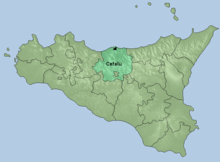Roman Catholic Diocese of Cefalù
|
Diocese of Cefalù Dioecesis Cephaludensis |
|
|---|---|

Cefalù Cathedral
|
|
| Location | |
| Country | Italy |
| Ecclesiastical province | Palermo |
| Statistics | |
| Area | 1,718 km2 (663 sq mi) |
| Population - Total - Catholics |
(as of 2013) 114,200 (est.) 111,700 (est.) (97.8%) |
| Parishes | 53 |
| Information | |
| Denomination | Catholic Church |
| Rite | Roman Rite |
| Established | 1131 (886 years ago) |
| Cathedral | Basilica Cattedrale della Trasfigurazione |
| Secular priests | 70 (diocesan) 30 (Religious Orders) 8 Permanent Deacons |
| Current leadership | |
| Pope | Francis |
| Bishop | Vincenzo Manzella |
| Emeritus Bishops | Rosario Mazzola |
| Map | |
 |
|
| Website | |
| www.chiesadicefalu.it | |
The Diocese of Cefalù (Latin: Dioecesis Cephaludensis) is a Roman Catholic ecclesiastical territory in Sicily, southern Italy. It is a suffragan of the Archdiocese of Palermo.
The first known bishop of Cefalù was Nicetas who, in 869, assisted at the Eighth General Council held at Constantinople for the trial of Photius. Marzo Ferro believes that the diocese was founded in the fifth century. Following Nicetas, the Arab occupation of Sicily made the regular election of bishops impossible. When Roger I of Sicily, rebuilt the city, Iocelmo was bishop. A confirmation of the privileges of the Church of Cefalù, granted by King Martin and Queen Maria on 10 June 1392, names King Roger as the ecclesiae ejusdem fundator (founder of that Church).
The Cathedral of the Holy Saviour was planned and begun under orders of King Roger in 1131. The mosaics were commissioned by King Roger in 1148. The basilica was consecrated on 10 April 1267, by Cardinal Rodolfo, Bishop of Albano, the Papal Legate. From its beginning the cathedral was served by a chapter which followed the rule of S. Augustine (O.S.A.). In 1671, however, under Bishop Giovanni Roano e Carrionero, the Chapter was converted by Pope Clement X into a corporation of secular priests. In accordance with Pope Clement's bull, the Chapter was composed of four dignities (Dean, Archdeacon, Cantor and Theologian) and eight Canons.
In the century between 1276 and 1376, for which there happens to be documentary evidence, the city of Cefalù saw its population drop from c. 11,000 to c. 2000. The Black Death no doubt played a major role in that catastrophe, though the Sicilian Vespers (which began in 1282) played a part.
On 5 March 1823 a major earthquake and a significant aftershock struck the entire northern coast of the island of Sicily. At Cefalù there was a tsunami that washed boats out to sea. The Gazzetta di Genoa reported that the upper part of the campanile of the convent of S. Francesco had fallen, and the convent of S. Pasquale had been destroyed, but that there had been no loss of life.
...
Wikipedia
